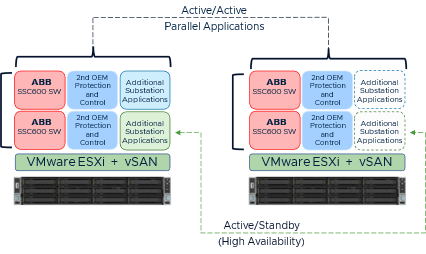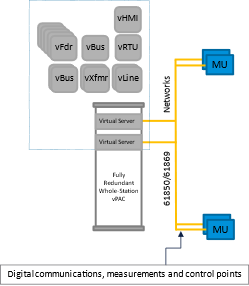Join VMware at DISTRIBUTECH 2023 in San Diego, February 7-9. We will showcase our joint solutions including virtual Protection, Automation, and Control (vPAC) and cybersecurity applications, with industry partners at the Intel, Dell, ABB, Advantech, Crystal Group, and L&T booths.
VMware is already at the heart of industry, including many utility companies. You’ll find our core products there, such as VMware vSphere (including the base hypervisor ESXi, and the holistic control plane established by VMware vCenter). The many benefits that come from software-defined infrastructure has led IT teams to transition their previous hardware-based systems into the abstracted, flexible, independent layers found within VMware Cloud Foundation. These include compute, storage, and networking. And each of these components can be administered from within a single suite of management tools.
Just as VMware infrastructure allows for simple and pliable expansion within the IT central locations, we are continuing to expand, through private wide area networks for utilities, out to the edge. This edge includes distribution, transmission, and generation facilities.

These substation workloads are Operational Technology (OT) applications such as critical protection relays running in “hard” real-time, automation and control functions that facilitate operational data acquisition and analysis, as well as the cyber and physical security and management of local resources. Those workloads, because they are removed from any existing hardware dependencies, are well-served by VMware Edge Compute Stack featuring full support for both containers and virtualized machines (VMs).
Core benefits of virtualization
The software-defining of applications comes with core benefits, which IT teams may have become so accustomed to, they now seem trivial. However, when we’re talking about performing these simple functions for newly transformed OT workloads (which used to consist of independent, fixed-function, physical machines), they can make the justification of technology migration more obvious.
Consider company standard templates, for instance. Contrary to the deployment of a physical device, a virtual appliance can forego the scoping for installation location, the plethora of wiring and any additional supporting pieces that may be needed, along with the verification of each physical connection and component. The VM can instead be deployed on a capable, local substation server in just minutes, ready for settings application. This cuts through the many hazards associated with physical wiring, where non-obvious mistakes are easy to make and to overlook.
Another function are backups, which can be performed for complete VMs, seamlessly as a background process, to either separate, or off-site, storage hardware for safekeeping. This can be automated for disaster recovery or could be done proactively, prior to making a major change, to safeguard devices that are in-service.
VMs can be cloned, providing a convenient starting point for a similar machine to be implemented. Or they may need to be migrated to another server, as required by hardware upgrades and/or replacements.

Absolute zero downtime is a requirement for critical grid applications, and protection and control appliances can be operated together in active-active topologies, just as they have been in the past. However, now virtual redundancy is also offered within a single, physical server. And, either of these methods are still managed entirely by the vSphere platform.
Most utility companies also agree that they want their applications to be highly interoperable, across different vendors, preventing being “locked-in” to proprietary technologies. This also provides a greater ability to assemble best-in-class components, ensuring the highest performance both now and in the future, as industry evolves.

VMware accepts and supports the use of industry-standard protocols, for additional assurance of long-term compatibility. At the heart of this are the IEC 61850 and 62439 specifications and communication types. Many vendors have offered these same protocols within their traditional hardware-based devices, but there, the benefits of I/O digitalization have not proven to be justification enough for many of their customers to make a full transition. Looking forward to the software-defined platform enabled by Edge Compute Stack, there are now complementary reasons for the energy industry to educate their OT workforce and adopt both digitalization and virtualization.
Emergence of world’s first protection and control software
VMware is very pleased to partner with ABB to host their SSC600 SW (first commercial virtual Protection and Control appliance) on VMware Edge Compute Stack, creating a complete and consistent solution with ‘hard’ real-time capabilities for power system protection and control. ABB has launched a foundational webinar series to promote and to provide additional information and education about their virtual appliance. There, UKPN and Intel share their experience, and VMware explains more about the value proposition of the software-defined substation application architecture.
See vPAC live @ DistribuTECH 2023
Join VMware at DISTRIBUTECH, hosted in San Diego in 2023 from February 7-9, where we will showcase our joint solutions with multiple industry partners. Solutions will include virtual Protection, Automation, and Control (vPAC), as well as cybersecurity applications, hosted at the Intel, Dell, ABB, Advantech, Crystal Group, and L&T booths.







